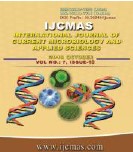


 National Academy of Agricultural Sciences (NAAS)
National Academy of Agricultural Sciences (NAAS)

|
PRINT ISSN : 2319-7692
Online ISSN : 2319-7706 Issues : 12 per year Publisher : Excellent Publishers Email : editorijcmas@gmail.com / submit@ijcmas.com Editor-in-chief: Dr.M.Prakash Index Copernicus ICV 2018: 95.39 NAAS RATING 2020: 5.38 |
A field experiment was carried out at Agricultural Research Station, Gangavathi, Karnataka during 2012-13 to 2014-15 A comparison of Laser guided leveler technology with zero tillage along with crop residue treatment and Farmers practice were carried out and it was found that Significantly higher yield and straw was recorded in the former practice (2450 and 2756 kg ha-1) as compared to later (1850 and 1950 kg ha-1). Similarly, number of plants per sq. meter area and plant height was significantly higher in laser leveling with zero tillage and 100% previous crop residue retained treatment and lowest in normal leveled land in farmers practice. Among eight treatment, the quantum of irrigation water applied was less in case of laser leveling with zero tillage with 100% previous crop residue retained treatment followed by laser leveling with zero tillage with 50% previous crop residue retained treatment and was more in case of farmers practice (control). The total water saving was to the extent of 27% in case of laser leveling with zero tillage with 100% crop residue retained treatment over control treatment. After harvest, the pH and ECe of the blocks varied between 7.9-8.66 and 4.04-9.04 dS/m at 0-15 cm and 7.87-8.68 and 3.76-8.25 dS/m at 15-30 cm depths respectively. After harvest of third year crop, slightly higher soil organic carbon content was recorded at surface depth (0-15 cm) in T7 treatment as compared to before sowing. It was concluded that, higher yield of wheat and water saving can be achieved in laser leveled land by using 100% previous crop residue retained in zero till land under saline soils.
 |
 |
 |
 |
 |